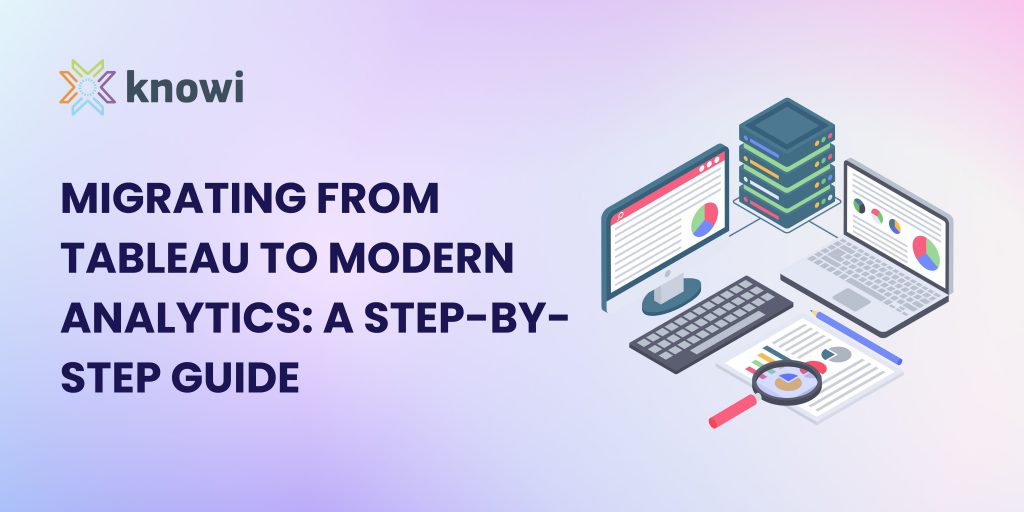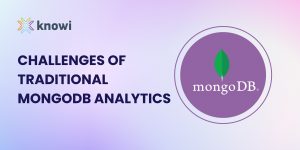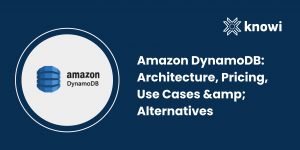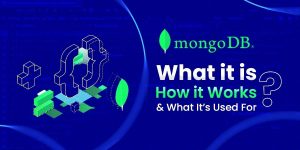TL;DR
Legacy BI tools like Tableau struggle with modern data needs, especially NoSQL, real-time, and AI. This blog walks you through:
- Why organizations are moving from Tableau to modern platforms like Knowi
- A side-by-side comparison of Tableau, Power BI, and Knowi
- Use cases for embedded analytics, real-time alerts, and AI-powered insights
- A detailed migration plan for switching from Tableau to Knowi
- Evaluation criteria, ROI insights, and common migration challenges
Key Takeaway:
If your stack includes NoSQL databases, APIs, or you want AI-powered, embedded, real-time analytics, Knowi offers faster deployment, lower TCO, and more flexibility than legacy tools.
Start your free trial or book a demo to see Knowi in action.
Table of Contents
Migration Guide: From Tableau to Knowi
Introduction
As organizations confront increasingly complex data environments, integrating MongoDB, Elasticsearch, Cassandra, REST APIs, and SQL databases, legacy BI platforms like Tableau introduce bottlenecks: ETL overhead, scaling constraints, inflexible licensing, and delays. In 2025, smarter alternatives like Knowi allow direct data access, AI-assisted querying, real-time streaming analytics, and embedded dashboards, all without building integrations from scratch.
This article explores:
- How Tableau, Power BI, and Knowi compare on features and cost.
- A migration framework to transition from Tableau to Knowi.
- Use-case scenarios and scoring methodology to determine the right fit.
- ROI insights, team readiness, and technical considerations.
You’ll gain actionable insights to drive informed technical decisions and determine whether a modern platform like Knowi can deliver accelerated analytics velocity, simplified operations, and strategic advantage.
Quick Comparison: Tableau vs Power Bi vs Knowi
Detailed Platform Analysis
Tableau

Overview: Industry-standard BI tool, excels in polished visual analytics with drag-and-drop ease.
- Strengths: Stunning dashboards; large user base; mature ecosystem.
- Limitations: No native NoSQL; relies on ETL; per-user licensing; slower rollout.
- Pricing: ~$70/user/month; also needs ETL investments.
- Use Cases: SQL-heavy organizations needing top-tier visuals.
- Reviews: Praised for design, criticized for integration complexity.
Power BI

Overview: Microsoft’s BI choice with tight Office/Azure integration and basic AI.
- Strengths: Affordably priced; natural to MS customers; includes AI features.
- Limitations: Limited NoSQL support; performance bottlenecks on large data.
- Pricing: $10/user/month (Pro); $20/user/month (PPU); embedded starts ~$5k/month.
- Best For: Office-aligned teams and small-scale analytics.
Knowi
Overview: Modern analytics platform with unified access to SQL, NoSQL, REST, streaming, and AI.
- Strengths:
- Native NoSQL (MongoDB, Elasticsearch, Cassandra)
- Unified cross-source joins
- Private AI engine for analytics and ML insights
- Real-time analytics & triggers
- White-label/embedded analytics with SDK
- Rapid deployment in hours
- Strong customer support
- Limitations: Smaller community; less visual polish than Tableau.
- Pricing: Custom annual plans (Basic, Team, Enterprise tiers), priced based on usage and features, with no per-user surprises
- Use Cases: Real-time insights, embedded analytics, hybrid data environments.
- Reviews: 4.8–4.9/5 across SoftwareAdvice, GetApp, Research.com
Head‑to‑Head Comparisons
- Data Connectivity: Tableau/Power BI rely on ETL; Knowi supports native multi-source analytics.
- Ease of Use: All have intuitive UIs; Knowi adds AI Q&A.
- Deployment: Tableau/Power BI take weeks; Knowi spins up in hours.
- Scalability: Knowi supports schema-less petabyte datasets; others need warehouses.
- AI/ML: Knowi includes private AI engine for analytics and insights; others require add-ons.
- Embedding: Knowi designed for OEM and white-label embedding.
- Support: Tableau has mature community; Knowi offers direct consultative support.
- Total Cost: Tableau/Power BI scale with users; Knowi offers predictable annual pricing.
Use-Case Scenarios
- Need direct NoSQL analytics? Choose Knowi to skip ETL.
- Embedding dashboards in apps? Choose Knowi for full SDK support.
- AI Q&A across data types? Choose Knowi for seamless natural-language interaction.
- Fast go-live pilot? Choose Knowi and Start Free Trial today.
Decision Framework
- Data mix: SQL only? Tableau/Power BI. Mixed? Knowi.
- User types: Technical only? Tableau. Mixed? Knowi.
- Budget model: Per-user? Tableau/Power BI. Annual cap? Knowi.
- AI/real-time needs: Built-in in Knowi; add-ons otherwise.
- Embedded needs: Knowi excels with white-label.
ROI: Save ETL costs, accelerate analytics velocity, embed insights, and cut total TCO.
Migration Guide: From Tableau to Knowi
- Discovery & Mapping: Catalog data sources and top Tableau dashboards.
- Set Up Knowi: Request pricing, deploy, connect sources, model data (Knowi team can support you in this journey).
- Recreate Dashboards: Rebuild 3 key Tableau dashboards; enhance with AI.
- Validate & Optimize: Ensure accuracy, tune performance, set alerts.
- Training & Change Management: Workshop AI Q&A; leverage embedded chat.
- Roll-out & Decommission: Launch platform-wide, retire Tableau, track ROI.
Timeline:
- Weeks 1–2: Pilot setup
- Weeks 3–4: Production ramp
- Month 2: Full switch
Challenges: Data quality discrepancies; user resistance. You can mitigate this with side-by-side demos.
Conclusion
Transitioning from Tableau to Knowi is more than a migration, it’s unlocking a modern analytics engine. Knowi’s native NoSQL support, unified analytics across SQL/NoSQL/REST, real-time streaming, AI-powered insights, and embedded white-label capabilities deliver the agility and scalability today’s organizations need. With custom annual pricing, deployment in hours, and built-in support, Knowi offers a transparent and efficient path forward. To see how Knowi fits into your stack, See Knowi in Action today.
Freuqently asked Questions
Does Knowi offer public pricing?
Is there a free trial?
Yes, a 21-day trial is available upon request.
Can Knowi connect to Elasticsearch natively?
Yes, no ETL required.
How fast can it be deployed?
Deployable in hours once pricing and setup are done.
What AI features are built-in?
Includes NLQ, NLG insights, anomaly detection, dashboard autogeneration.





